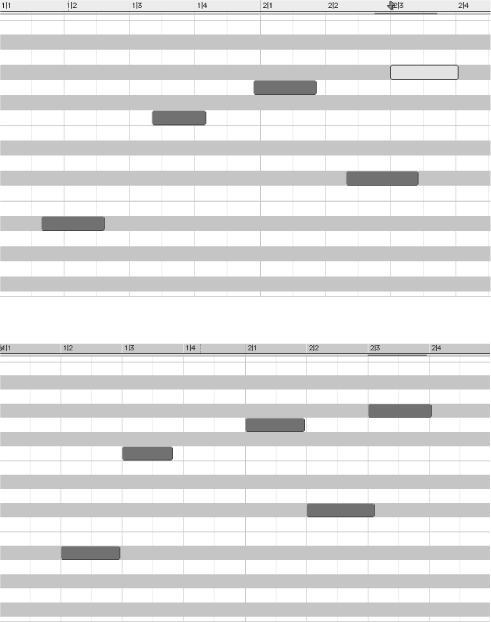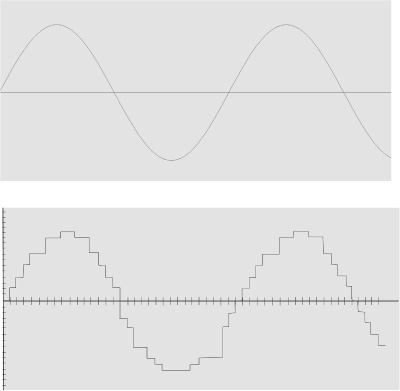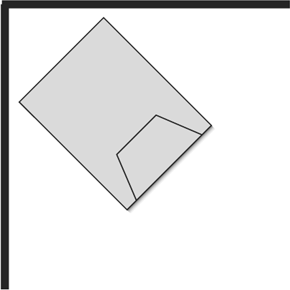Q. Short for quality factor, a.k.a. resonance. The term Q is often used interchangeably with bandwidth, but in fact Q determines the bandwidth. The sharper (higher) the Q, the narrower the bandwidth, and vice versa. 1. Q refers to the sharpness of a resonant peak in a synthesizer filter. 2. In equalizers, Q is the center frequency divided by the half-power bandwidth. If an EQ band has a center frequency of 250 Hz and the bandwidth at half power is 100 Hz, the Q is 2.5. 3. In speakers, Q refers to directivity, or how energy is dispersed from the driver. A speaker Q of 1 indicates equal energy dispersed in all directions. A speaker Q of 2 indicates 180-degree dispersion; the higher the Q, the narrower the dispersion.
quad core. A single die or chip containing a four-core computational processor, allowing multiprocessing on a single chip. ![]() See also core, Multi-core.
See also core, Multi-core.
quadraphonic. Literally, four-channel audio, though most people will think of the 1970s four-channel speaker system (left and right in the front corners of the listening space, and left and right in the back corners). Quadraphonic material was available on eight-track tape, LP records, and reel-to-reel tape in a number of competing formats, including CD-4, Q4, Quad-8, SQ, QS, and Matrix H. The excess of formats combined with lack of interest from consumers in purchasing extra speakers and other equipment killed quadraphonic.
quadratic residue diffusor. Acoustical device designed with a random surface pattern using mathematical formulas. ![]() See also diffusion, diffusor.
See also diffusion, diffusor.
quadrature. ![]() See phase quadrature.
See phase quadrature.
quality factor. ![]() See Q.
See Q.
quantization. Literally, dividing a continuous signal or event into discrete steps (see Figure Q.1). 1. In digital audio, discrete measurements are taken of a continuous analog signal and represented as discrete binary data using bits for storage. 2. In MIDI sequencers and drum machines, the timeline is divided into a grid at a certain timing resolution (usually measured in PPQN—pulses or parts per quarter note), and each rhythmic event is quantized, or moved to the nearest grid location. The higher the resolution, the finer the grid, and the more “human” the performance can be. Older sequencers might have a resolution of 48 or 96 PPQN, while modern sequencers can have an internal resolution as high as 1,920 PPQN.
quantization error. Errors resulting from attempting to represent a continuous signal or event with discrete steps. With digital audio, in most cases the measurements of the analog signal will not fall exactly on the digital “steps.” In this case, the measurement must be moved to the nearest step. The difference between the actual value and the nearest digital step is the quantization error, which appears as extra harmonics in the signal. Because the samples go by so quickly and the signal is constantly varying, these harmonics are perceived as noise. (See Figure Q.2.) ![]() See also quantization noise.
See also quantization noise.

Figure Q.2. Quantization error results from the difference between an actual value being measured and the discrete, quantized steps used to represent that measurement.
quantization noise. Wideband noise resulting from the collective quantization errors in a signal. ![]() See also quantization error.
See also quantization error.
quantize. To move a rhythmic event to correspond closely or exactly to a timing grid. ![]() See also quantization, quantizing.
See also quantization, quantizing.
quantizing. A feature of MIDI sequencers and drum machines that moves MIDI events to match a timing grid (for example, to the nearest eighth or sixteenth note). Quantizing can be used for correcting or modifying a rhythmic performance or for producing a mechanized feel. See Figure Q.3.

Figure Q.3. Moving MIDI events to match a timing grid is called quantizing. The MIDI notes at the top have not been quantized; the bottom shows the same notes after they have been quantized to the grid.
quarter space. A sound source, such as a speaker, located at the junction of two surfaces, such as the corner of two walls, is said to be in quarter space. Quarter-space placement of a speaker or other sound source results in a 6-dB level increase (mainly in the low frequencies) over free-space placement (see Figure Q.4). ![]() See also free space, half space, eighth space.
See also free space, half space, eighth space.
quarter track. A configuration of an analog tape or tape recorder head that allows for four tracks, with each track taking one quarter of the tape-head width. In a professional multitrack machine, the four tracks will be configured as independent tracks that can be recorded simultaneously. In stereo consumer and mixdown recorders, whether cassette or reel-to-reel, two tracks will be recorded/played in one direction, with a second set of two tracks recorded in the other direction by flipping the tape over.
quasi-parametric (a.k.a. semi-parametric). An equalizer band that allows changing the frequency and cut/boost, but not the bandwidth. Many mixing consoles feature quasi-parametric “sweepable” midrange bands. ![]() See also sweepable mids.
See also sweepable mids.
QuickTime. A multimedia format developed by Apple Inc. for the Macintosh, for storing, playing, and interchanging audio, video, and graphics. Now also available for the Windows platform.
quiescent noise. The operating noise produced internally by audio devices combined with the background noise in a room. This includes hum, hiss, and air-conditioning noise, as well as any noise in the environment.
QWERTY. The standard layout for computer keyboards and typewriters in English. Refers to the first six alphabet/letter keys on the upper-left of the keyboard.


